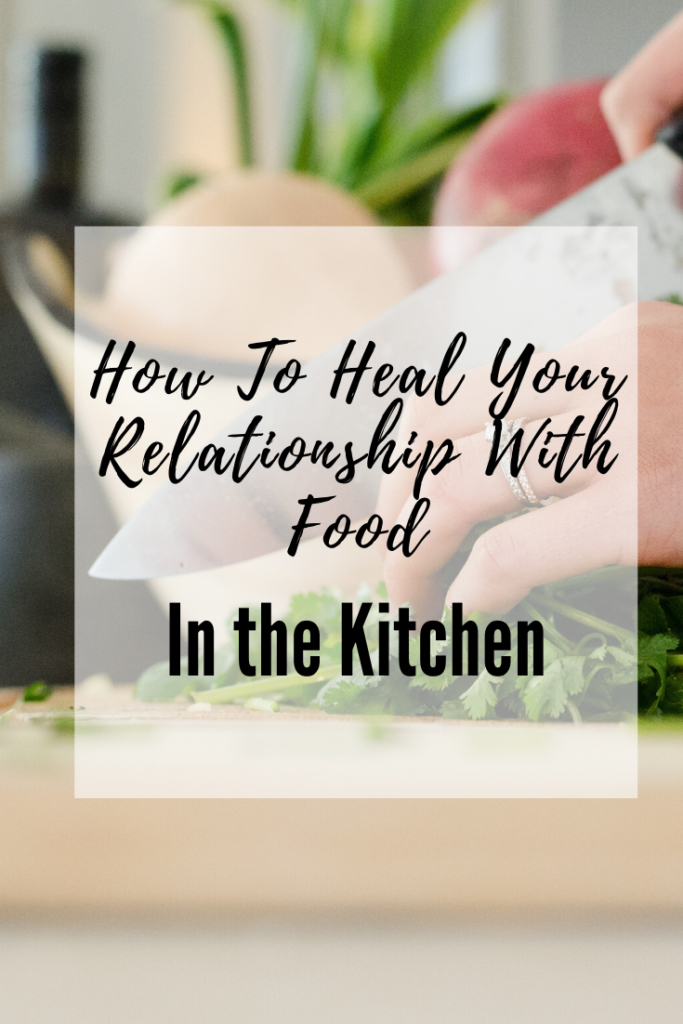Dieting and diet culture can make cooking a not-so-enjoyable experience. When you’re working to move away from diet culture, the kitchen offers a beautiful opportunity for healing and growth towards a healthy relationship with food. In this post, my intern (and incredible chef!) Callie Troutman shares practical ways you can incorporate intuitive eating into recipes, cooking, and the kitchen. (Don’t miss her free recipe e-book too!)
For too long, diet culture has ruled the kitchen. While there are some outlets that now offer content celebrating food cooked over your stoves and in your ovens (I’m loving the videos from Bon Appétit right now), in so many ways wellness culture takes this part of your living spaces and turns it into a tool for control and restriction.
Open concept, closed concept, galley, or kitchenette. I like to think of the kitchen as the place where the rubber hits the road with intuitive eating. In other areas of your house you can suppress or choose to glaze over your disordered memories with food, but in the kitchen all of those former thoughts, rules, compensations, etc. stare you in the face.
For this reason, some people find it helpful to avoid the kitchen in the early stages of eating disorder or disordered eating recovery. That is for you to decide in conjunction with the advice of your care provider. When you are ready though, the kitchen offers a beautiful opportunity for healing and growth in intuitive eating towards a healthy relationship with food.
Whether you hail from the casserole region of the United States, a temperate land of year-round fresh produce, or somewhere else, those of us who are privileged enough start our lives with a positive, or at the very least neutral, relationship with food, cooking, and the kitchen. Somewhere along the way, diet culture and/or wellness culture turned the kitchen into an apothecary of protein powders and green supplements, a holding place for “acceptable ingredients,” or an assembly line for unsatisfying meal prep.
Because of this, many people stop seeing food as a conduit for nourishment, pleasure, and happy memories, instead of becoming only a way to “cleanse” or “optimize” the body, full of rules that dictate what you can and can not cook or eat. If that sounds familiar, it is NOT your fault you believed those things. We are told very convincing stories about how our bodies need this “clean” or “natural” ingredient. What we lose however is a connection to our food. We’ve “cleaned” out our cabinets so much that they have become sterile holding spaces rather than laboratories for creativity and connection.
Incorporating Intuitive Eating Recipes & Cooking
I believe the kitchen is one of the best tools for healing your relationship with food, regardless of your skill level or level of comfort in the kitchen. The cooking process, and subsequent eating process, offers a million opportunities to explore food with curiosity and self-compassion. In fact, curiosity and self-compassion are my two favorite kitchen tools.
Curiosity will keep you focused inward, asking questions, and discovering answers. It will also help you reframe your supposed “missteps” into opportunities for learning. Self-compassion will keep you present, connect you to the collective struggle against diet culture messages, and keep you patient when you face struggles.
Maybe the kitchen isn’t a place of joy for you right now. That’s ok! Learning a couple of skills or quick dishes to whip up may be helpful for keeping yourself nourished in a pinch. Who knows, you may even find yourself enjoying it.
[br]Break the Rules
Diet culture tells you when to eat, what to eat, and how much to eat. Exactly what these rules are becomes apparent when you look at other cultures. Those of you who are from Japan or have traveled to Japan may know that the first meal of the day for many people in the country includes foods like pickled vegetables, miso soup, rice, fish, and salad. For many of you, these foods are not considered traditional breakfast foods. If you ever get an opportunity to try them however, take it! We miss out on so many wonderful eating experiences when we limit our acceptable foods.
This may surprise you, but your body does not care if you eat pizza for breakfast and eggs for dinner. A carbohydrate is a carbohydrate, a fat is a fat, and a protein is a protein. Ditch any rules that tell you you can’t eat x before x o’clock, or y after y o’ clock. After you do this, the kitchen will feel like a much friendlier place.
For many of you, rules have been your comfort zone in the kitchen. Be compassionate with yourself as you seek to break these down and cook what feels right for your body when it feels right.
Use ALL Ingredients
Diet culture demonizes certain ingredients, limiting your “palettes” and creative freedom in the kitchen. One of the steps to recovering a positive relationship to food is deciding to use all ingredients (there will be times when you might limit or restrict certain ingredients for moral and/or religious reasons, which is completely fine).
Think about a highly-rendered painting. One that looks so real it could be a photograph. It has light areas and dark areas, and the artist likely used a wide array of pigments to achieve lifelike qualities. I think we could all agree that if that artist were limited to a much narrower range of “approved” pigments, the painting would not turn out the same. Not only that but after time I bet that artist would start feeling uninspired by such a narrow palette.
Cooking is the same! When you open up your ingredient “palette” to include all flavors, textures, and colors of foods, it can be surprising where you find inspiration.
Neutralize Ingredients
Not only is it helpful to USE all ingredients while cooking, but it is also helpful to take that a step further by neutralizing all ingredients. If we still use an ingredient but think of it as “bad,” we have not truly neutralized our relationship to that ingredient.
One way to start encouraging an even assessment of ingredients is in the way you plate your meals and snacks. This means putting your dessert, sides, and entrees all together on the same plate. In this way, it won’t feel as if you are earning any foods. In disordered eating and eating disorder recovery, you often have to take action before your emotions and/or thoughts can catch up.
Be Present
One of the toughest parts of intuitive eating is that you can’t just look at the way someone else eats and mimic what they eat, when they eat, and how much they eat. That is called a diet – as is any other external or extrinsically directed way of eating. Instead, you have to get back in touch with your body. If you have been dieting for a long time this may be confusing and counterintuitive at first, but I promise it will start to make more sense as you put in the work.
Alissa has talked about mindful eating in the past on her blog and I also believe that mindfulness can be part of the cooking process. When you are present for the sights, smells, and textures of your ingredients and food they take on a more nuanced meaning beyond objects to fear. Meditating on feelings of hunger, fullness, and satisfaction can lead to more comfortable and fulfilling eating experiences.
Show Yourself Love
One of the ways we show people we care about them is through our time and energy. Considering what they are going through, dedicating thought to their feelings, etc. In the same way, you can care for yourself by considering your body’s needs and how to meet those needs.
Not all of us have the luxury to spend hours in the kitchen cooking and cleaning. Not all of us have the finances to spend money on fancy meals with loads of ingredients. No matter your current circumstances, putting thought behind how to nourish your body and the bodies of those you love can be an important foundation for self-love and respect.
Diet culture co-ops this idea often and convinces us that we are taking care of ourselves only if we are eating “diet-approved healthy” foods. This is absolutely not the case. Our bodies need nourishment in the form of macronutrients, micronutrients, minerals, emotional support, and satisfaction.
Explore Your Preferences
After years and years of following external diet rules, asking yourself what you want to eat can feel wrong- like you are doing something you “shouldn’t” be doing. This idea of eating foods that sound good in the moment is called satisfaction. Healthy eating patterns take into consideration hunger, fullness, AND satisfaction. The more in-touch you are with your body the more you will be able to identify which foods you are craving.
One of the greatest ways to connect back to what you enjoy eating is by experimenting in the kitchen. You may be surprised by exotic ingredients you enjoy, or foods you ate all the time that you actually don’t enjoy that much. The fun thing is that our tastes and preferences change, so the experimentation process is never-ending.
Curiosity and compassion will carry you far in the kitchen. Keep them close and sharpen them often.
What are your favorite things to cook in the kitchen? How has your experience in the kitchen changed over time? Let me know in the comments below!
This blog post was written by Callie Troutman, a dietetic intern living in New York City. Follow her on Instagram (@callietroutman) or on her website for recipes and inspiration for finding joy in the kitchen!








